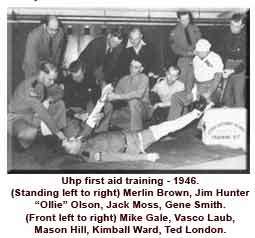The Post War Years
At the conclusion of World War II, Utah – as well as the rest of the country – entered the baby boom era. The war was over, life was grand, and alcohol was a major problem. The 35 mph War Speed Limit was dropped. The speed limit reverted to 60 mph in the day and 50 mph at night. These factors resulted in an immediate increase in accident and fatality rates.
On August 6, 1945, Colonel Dow announced that all Utah Highway Patrol officers would work 10-hour days. This would allow coverage of county as well as state roads, and hopefully, reduce the number of accidents. Patrolmen worked six days a week for the next two decades. One officer recalled, “Time didn’t mean anything in those days. We had a job to do and we did it without worrying about the overtime hours we spent.”
Also in 1945, black and white patrol cars were implemented for better visibility in an attempt to further reduce traffic accidents. Motorcycles, which had been used since the beginning of the Patrol were also phased out.
 The Patrol averaged 12 to 15 DUIs per month during the war years. Immediately following the war, this rate soared to over 40 DUIs per month. Furthermore, many problems with vehicle equipment were detected. The Patrol implemented numerous roadblocks to combat this problem. During one blockade from 2:00 p.m. to 5:30 p.m., a total of 94 large trucks were stopped and inspected. Only 12 trucks passed inspection. Traffic increased rapidly following World War II. Despite this increase, the Utah Highway Patrol struggled with budget cuts. The Patrol’s force of 70 officers in 1941 had been whittled to 58 officers by 1948.
The Patrol averaged 12 to 15 DUIs per month during the war years. Immediately following the war, this rate soared to over 40 DUIs per month. Furthermore, many problems with vehicle equipment were detected. The Patrol implemented numerous roadblocks to combat this problem. During one blockade from 2:00 p.m. to 5:30 p.m., a total of 94 large trucks were stopped and inspected. Only 12 trucks passed inspection. Traffic increased rapidly following World War II. Despite this increase, the Utah Highway Patrol struggled with budget cuts. The Patrol’s force of 70 officers in 1941 had been whittled to 58 officers by 1948.
Several remote areas of the state were particularly dangerous. One such area was the Uintah Basin. By 1946, the Rangely, Colorado, oil boom had hit. Club 40 was built at Artesia, Colorado. The midnight oil crews would stop for a few drinks before driving home to Vernal. Two dance halls west of Vernal were also hot spots for accidents. The Indian Reservation at Fort Duchesne and the high consumption of alcohol contributed to the problem. In one year, Sergeant Sam Hatch investigated 204 accidents, 14 of those involved fatalities. Sam recalled that he did not have time to properly investigate these accidents, just complete the paperwork and move to the next one.
To add to the problem, there were no ambulances in the Uintah Basin at this time. Sam would later recall, “We did the best we could with the injured. We sent them to the hospital on the floors of passing cars or in the back of pickup trucks. Hospitals and doctors often received these victims without any prior notice. Swain’s Mortuary had a hearse, which could be used as an ambulance. However, the problem was that Bessie Swain, had three boys who dated and partied in the hearse. Often, when the police had an emergency, the hearse could not be found. Furthermore, there was no overtime. Sam once stated, “Overtime was to me a nasty word. We had a job to do. We were all dedicated police officers. We all got along fine.”
